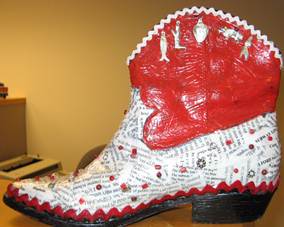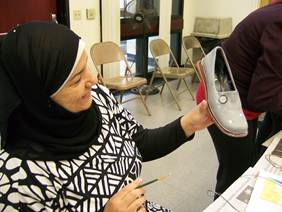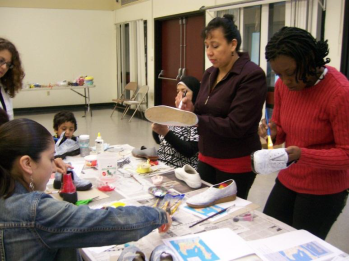 |
 |
|
|
Altered Shoes
Three of the programs in the Managing Stress project chose to experiment with altered shoes. Because shoes are already evocative as a metaphor for journey - past and future - we thought an altered shoe project would allow students to reflect on their life journeys - where they have walked, where they are walking now, where they want to walk - by using imagery, color, and collage. The project allowed for a range of entry points and engagement - from sensory engagement to written reflections. Read on to learn more about how ABE, ESOL, and pre-employment programs adapted altered shoe projects with their students. 
The inspiration for our altered shoes project came from an experience that I had on one of my first days in my position as am employment specialist at Vermont Adult Learning. I was meeting with a client, and I immediately noticed that he was wearing work boots that had the soles falling off, tattered laces, and duct tape to hold one of the shoes together. I remember looking at the boot and thinking to myself, 'This gentlemen has a story to tell.' Turns out he was a construction worker that had been out of work for a long period of time. He had no car and had been walking everywhere he needed to go. I began to think about how our shoes are symbolic of who we are, where we have been, and where we hope to go in our lives. It is my hope that this project will allow students to reflect on their lives and express that through this art medium.Linda reports that one woman, who had recently suffered the loss of a loved one, was especially engrossed in her project and found it to be the first activity in a long while to give her solace and comfort.- Linda Snow, employment specialist at Vermont Adult Learning For an overview of an altered shoes project, see Lenore Balliro’s mini-curriculum guide, Altered Shoes Lesson: Tracing a Journey. Sarah Bayers's Life Journey Through Altered Shoes gives a detailed description of their project and contains links to the tools they developed to guide the process. You can also read samples of Student Writing about Altered Shoes. Lisa Gimbel and Jeri Bayer of the Welcome Project developed an ESOL curriculum unit, The Story of an Altered Shoe Project. Shoes became a prompt for discussing journeys and transformations from students’ home countries to the U.S. In addition to learning new vocabulary, idioms, and language structures, students spent a part of two classes doing hands-on activities that triggered talking, laughter, sharing, and camaraderie among the students from several different countries who had only recently Most of the students found the activity relaxing and comfortable, and one woman said: I'm happy because I like to paint. I’m thinking of my kids. Now I see I can do this at home with my kids. I am forgetting bad things when I do this. If I cover the table with paper I can clean up after.
|
| New England Literacy Resource Center |
Copyright 2008 World Education, Inc.
Comments/Questions? Email us at wei@worlded.org
 A relatively new movement in the art world involves "altering" objects from their original purpose and transforming them into aesthetic artifacts with multiple layers of meaning. In the growing altered shoe movement, artists transform ordinary pairs of shoes into something sculptural, metaphoric, symbolic, whimsical, or simply decorative.
A relatively new movement in the art world involves "altering" objects from their original purpose and transforming them into aesthetic artifacts with multiple layers of meaning. In the growing altered shoe movement, artists transform ordinary pairs of shoes into something sculptural, metaphoric, symbolic, whimsical, or simply decorative. come tog ether as a class.
come tog ether as a class.